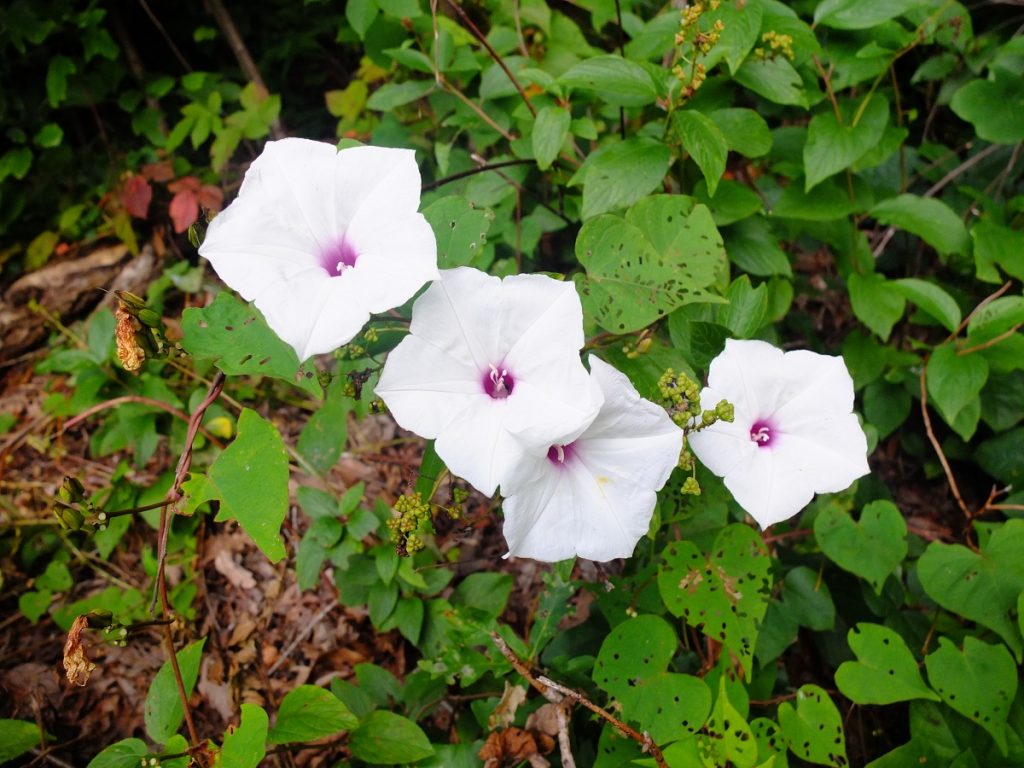
One of the most useful aspects to learning plant families is the way one begins to find and see the connections between seemingly separate species. Take the flowers of Ipomoea pandurata above… five-petaled big white morning glories with fuchsia centers, on a sprawling vine of heart-shaped leaves.
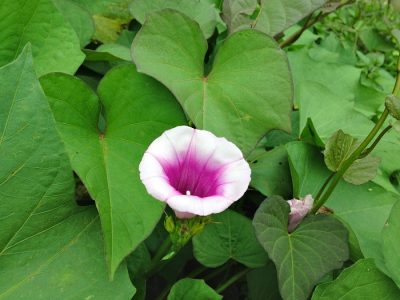
Now check out the next picture of Ipomoea batatas. See the similarities? What you might not know is that Ipomoea batatas is none other than the sweet potato, beloved of many and my personal favorite garden root crop.
The similarities don’t end there. Like Ipomoea batatas (eye-pom-ee-uh buh-tatas), Ipomoea pandurata also forms a large, edible underground tuber. So large, in fact, that it has been called manroot or man-of-the-earth. The tuber is shaped roughly like a human and can grow to be over 40 pounds! It’s also been called mecha-meck, although I do not know in which language. Presumably it is from the southeast and may be Cherokee. I also call it wild sweet potato vine. It’s in the morning glory family or Convolvulaceae and grows in a variety of places east of the Rocky Mountains such as in sunny, dry soils, floodplains, and the edges of woodlands.

Before you get too excited about a 40 pound wild sweet potato, most foragers who have dug up a large one and tried to eat it have reported everything from “unpleasantly bitter” to “horribly bitter.” Because of this, mecha-meck has gotten a bad rap. Now I have never personally dug up a very large root of this species to try to eat, so I cannot comment on the big ones. However, I have eaten the young roots, and am happy to report that the taste is delicious… crisp and crunchy like a carrot or parsnip, with a flavor very much like sweet potato. I have eaten it raw and also cooked. I recommend cooking if for no other reason than that it renders the nutrients inside the root more bio-available. I consider the plant important and worthy of focused propagation. Further experimentation however is warranted to determine the upper limit in size for edibility before the bitter flavors set in.
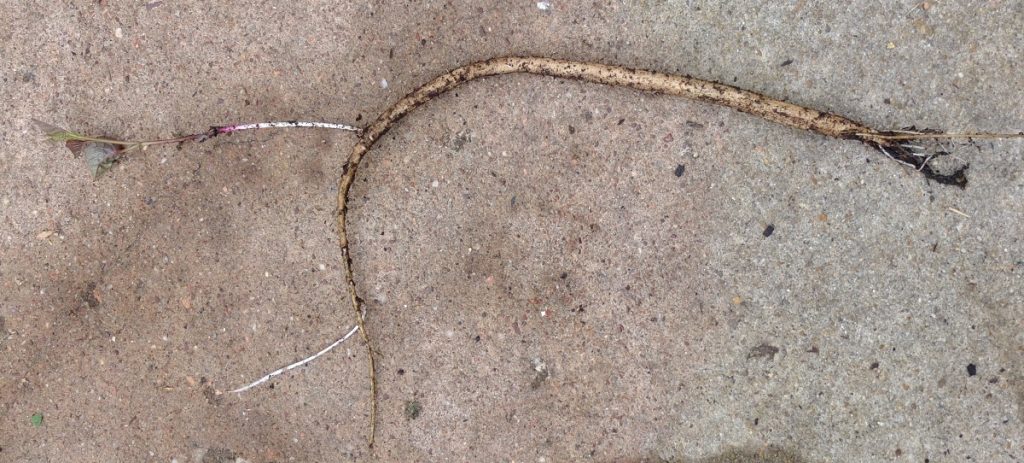
The fact that old roots don’t seem worth eating except in cases of survival, but young roots are delectable, highlights the necessity for tending of this indigenous plant’s populations if they are to be considered viable food for humans. Of course, selfish reasons like that shouldn’t be the only reason to care for plant populations, but tastiness certainly is a helpful motivator. To understand why this species benefits us more through our care, let’s consider the growth habit and life-cycle of mecha-meck.
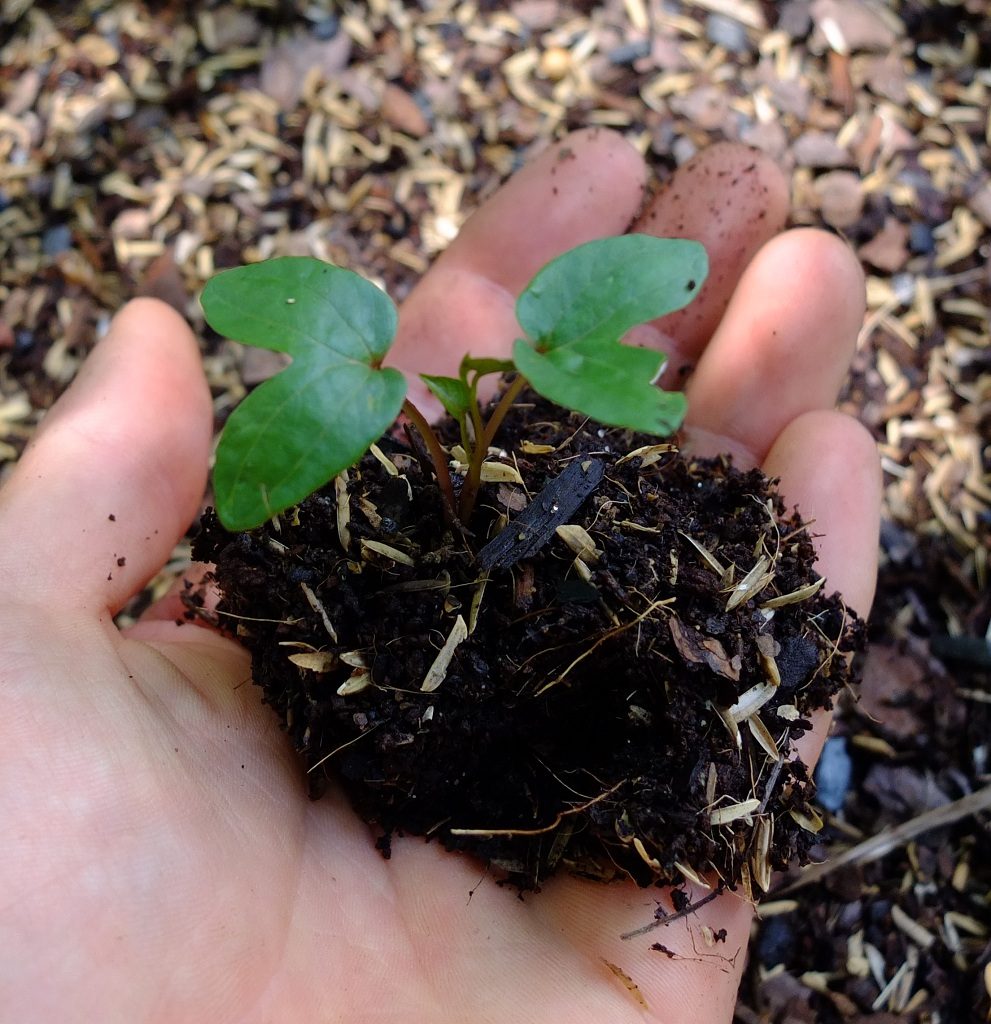
Mecha-meck begins like pretty much every other morning glory seedling I’ve ever seen, as a pair of chevron or V-shaped cotyledon leaves. The cotyledons linger for awhile (sometimes for several weeks) before the true leaves emerge. These are heart-shaped.
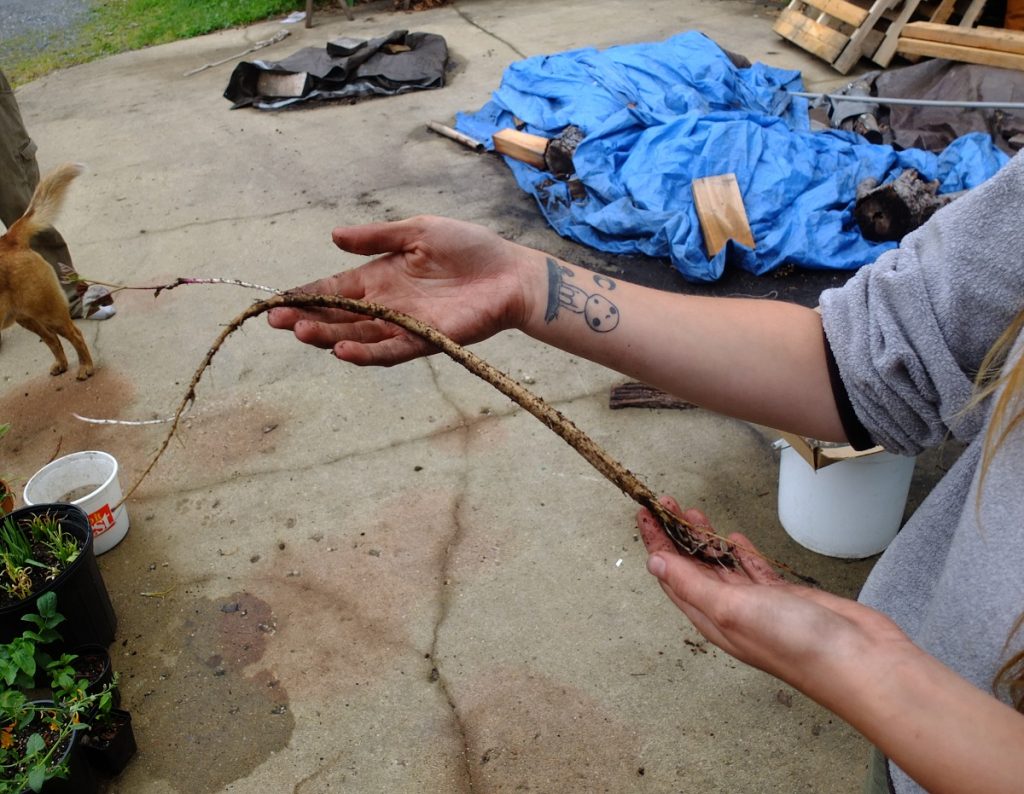
This is a slow-growing plant. For two or three years, it won’t look like it’s doing much. But that’s because below-ground, it is working on building it’s taproot. There won’t be any flowers for a few years either. By the time the plant begins to really stretch out and climb, it has an established taproot, like the root being held in the picture above. At this age the root is fleshy and crisp and succulent. When the vine begins to really sprawl is when the plant will first flower, too.
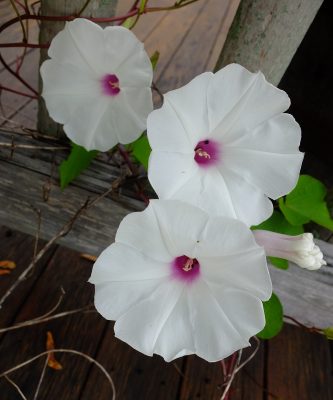
Where there’s flowers, there’s the potential for seed. Ipomoea pandurata is an outcrosser — as are other species in the genus Ipomoea, including sweet potatoes — meaning that the flowers need to be cross-pollinated with a flower from a different individual in the population in order to set viable seed. If you have only one plant, you will never get seed because Ipomoea pandurata is self-incompatible.
If one were integrated within the multi-generational cycle of Ipomoea pandurata, they could be digging roots and sowing seed from all the plants that had flowered in that year. Of those seeds planted that same year, it would be a few years before they too flower and set seed. In simpler terms, mecha-meck can be grown on a few years rotation, and with a large enough population, that would ensure a supply a fresh, young roots every year. This benefits humans because they get to enjoy a harvest of delicious roots, and the plant receives the benefit of being a stewarded population, resulting in boons such as increased genetic diversity via the intentional planting of seeds.
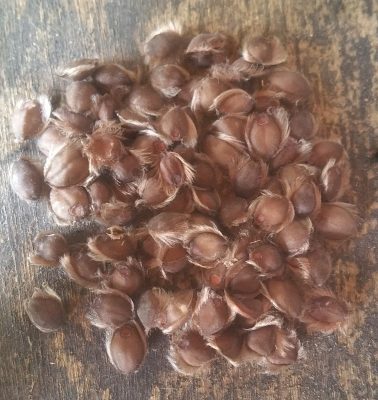
Mecha-meck is also easy to cultivate. When the seeds ripen, the “fruits” or seed capsules will rupture, offering up four brown, oval seeds with fuzzy margins. They remind me of insects, looking like brown flies.
Mecha-meck will flower throughout the summer months of late June, July, and August. The seed is not ready all at once but sequentially, with every flower. Seed can thus be gathered from the same plant a few times during the year.
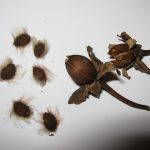
The seed doesn’t need a cold period (stratification) but will germinate whenever moisture and soil temperature levels are correct. Keep this in mind before sowing too late in the year when they might not have enough time to develop enough to survive the winter. The seeds are best sown in the spring when there is no more danger of frost. I put them under the soil only about a quarter inch or so. This results in high germination. You could also simulate the wild and get away with scattering them (surface-sown), but germination will be more erratic.
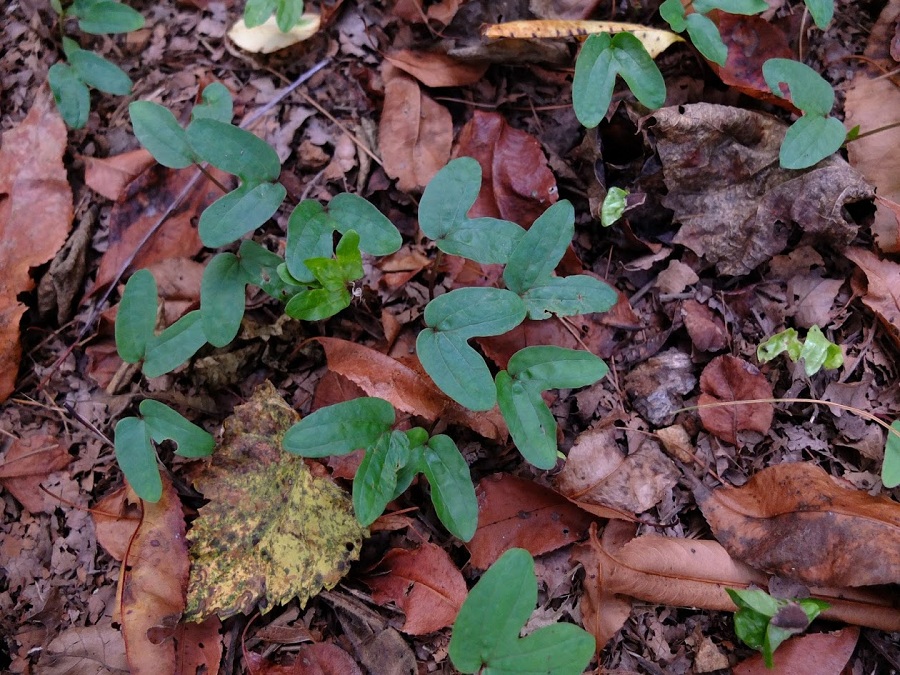
I have wondered whether wild sweet potato vine can be propagated asexually, through vegetative cloning. An examination of the root looks like it would be conducive to this… multiple vines often come from out of different portions of the root, and a close look at the root reveals various buds similar to the eyes of a potato. On-going experiment will confirm whether root division is a viable method of multiplication.
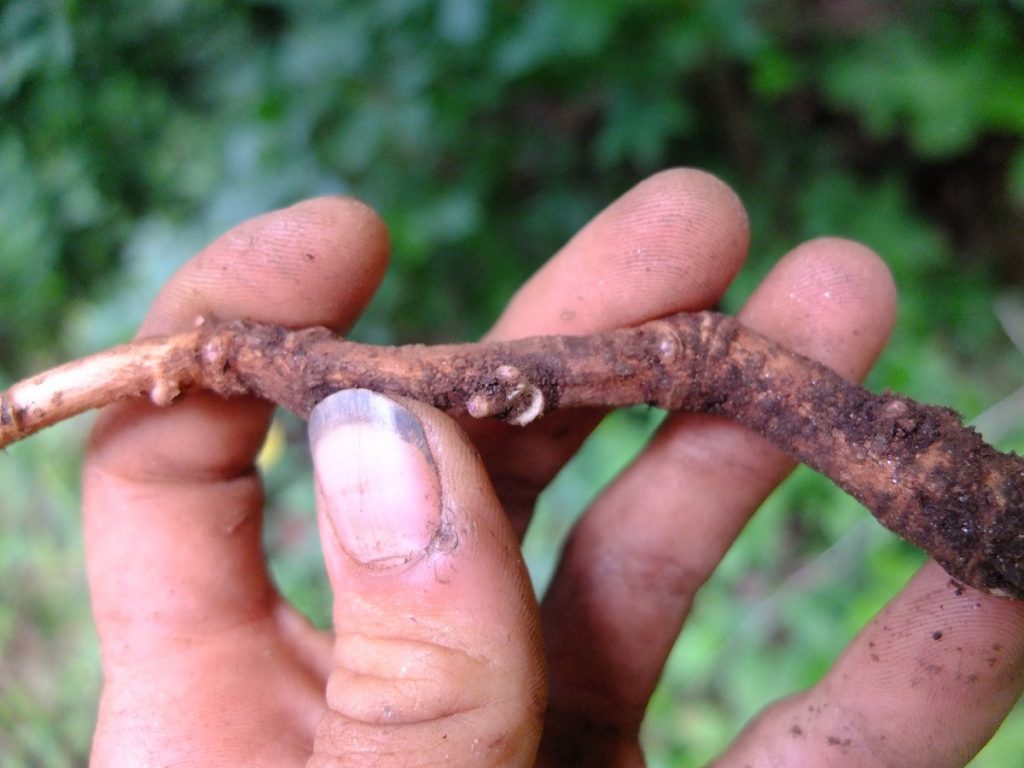
One thing I didn’t mention yet is that the leaves of mecha-meck are also edible, just like sweet potato leaves.
Many species in the genus Ipomoea have seeds which contain the ergine alkaloid d-lysergic acid amide or LSA, which is just two ethyl groups away from being LSD. Consuming for instance the seeds of Ipomoea purpurea (common morning-glory), results in psychedelic, entheogenic experiences. Some people call them hallucinogens but I think of them as lucidogens, and it is powerful medicine to be respected. LSA may or may not be present in the seeds of Ipomoea pandurata.
In North America there is at least one other tuber-forming sibling to the mecha-meck, and that’s what the Pawnee call Kahts–tuwiriki meaning “whirlwind medicine” (possibly because of the ergine). It’s also known as the bush morning-glory or manroot, Ipomoea leptophylla, and is a prairie species of the mid-west and upper Great Plains.
Around the world, other tuberous Ipomoea species used as food besides the sweet potato include Ipomoea mauritiana (giant potato or vidari kand), Ipomoea costata (bush potato, ghundi, yarla), and Ipomoea simplex.
Ipomoea pandurata is a diploid and Ipomoea batatas (sweet potato) is a tetraploid, but the two may be theoretically crossed. Crossing the two would be a really interesting experiment in raising the cold-hardiness of the sweet potato, which is frost tender and can only survive as a perennial in the tropics and sub-tropics.
Mecha-meck has many look-alikes such as the bindweeds (Convolvulus spp.), and other morning-glories. The fuchsia center against the large white flowers sets it apart, but if you are trying to identify the plant only by the leaves things are trickier. Anyhow, I invite you to take a closer look at this plant. Don’t pass it by!
An excellent and informative post on an intriguing plant. Thanks.
Hey, i have been taking down an old wooden fence,cleaning out the fence row, painting and rebuilding a new wooden fence…I’ve been having to move the small Azaleas…that i had planted along the old fence years ago!
Only to find a small seedling of what appeared to me being a morning glory…
The vine has now grown, while i have continued building the fence over this summer…It has heart shaped leaves with very small dime sized five point starred flowers of purplely white…Is there a chance it may be a wild Man of Earth?…
“Sweet Potatoe”
James,
Saint Augustine, Fl.
This was the best article I’ve ever read on Ipomoea pandurata. I got my start from root cuttings but it’s somewhat difficult to get them to take as it is so hot when I’ve found them in the wild. I’m in Topeka Kansas and this seems to be the upper limits of its range as I rarely encounter the plant.
This happens to be one of my favorite plants for the garden. It is a great boon to our bumble bees as they seem to be the main pollinator of the plant. I have yet to try eating it but now I plan to. Does it matter the season that it is harvested.
The older folk used to say not to eat them after they were three years old. That said, I believe you can pull out some of that bitterness by boiling it. If it’s still bitter boil it some more.
Aaron, thanks for this… interesting! Who did you hear this from? I’ve been able to pull out some of the bitterness through boiling as your mentioned, but generally don’t bother if the plants are old. They also get dense and fibrous when old. — Zach
I used to spend a lot of time with my grandparents and sometimes they’d talk about plants and their uses when we came across them in the yard. They believed that our folks and other tribes in the Southeast had cultivated this plant and other species of “sweet potatoes” as a food crop.
Another one that they ate was the pink moon flower and the white star morning glory. I think there was another but I can’t remember. Some people think we may have even grown actual sweet potatoes at some point. Which would make some sense ’cause a lot of the southeastern tribes are thought to have migrated north from central and south america.
Hi Aaron. Thank you for sharing! I have one or two overwintering seedlings of the pink moonflower and several more seeds for the spring. Pink moonflower (Ipomoea macrorhiza) seems especially promising. I suppose i should look into the whitestar too. By chance, were you passed down any names for these native sweet potatoes? –Zach
We haven’t had any fluent speakers in our family since at least my great grandparents. Even then, our folks had been associating with Europeans for quite a while before that so if the names aren’t recorded anywhere they were probably lost. Sorry. Either that, or they just referred to them by the same name. Some tribes used the same word to refer to any kind of plant with potato-like roots.
Speaking of the white-star, they don’t usually grow very large roots. At least in the wild. Like most sweet potatoes they’ll probably need to have soft dirt that isn’t tightly compacted in order for the roots to get to full size. Size may also depend on the fertility of the soil. I’ve never found a wild one with a potato any larger than the last digit of my pinky finger. They may not have actually been cultivated but used as a famine food because of their small size.
A friend brought me back to calif. a young plant of pandurata from Tennessee. It went on to bloom , refuses to set seed, so you are certainly right about cross pollination required. However I also have a plant of I. Mauritania ( digitata ) and so I crossed it with the pandurata. This primary hybrid seedling seems to be dominant for Mauritania in both leaf & flower. But now I’m back crossing to see what I get next. Ipomoea is a fascinating Genus. I’d like to grow as many species as I can.
Thank you for this post. I managed to get some fresh seed for this plant and this has been most helpful in how to get them to germinate. Since you said they don’t need stratification I will wait until Spring!
Great article – thanks! I’m in Ontario, Canada at the northern limit of Ipomoea pandurata’s range. Because it is so rare here, it’s on a locally endangered species list, so we can’t buy local seed.
Do you have any seed available? With climate warming I’d like to try to grow it here in Toronto. I’m part of Project Swallowtail, a native plants for native pollinators project (projectSwallowtail.ca).